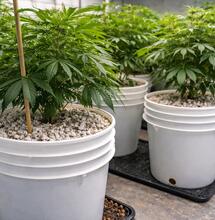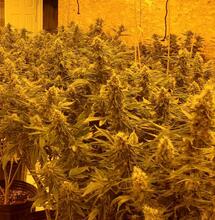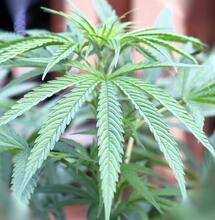Growing Cannabis Using Beneficial Microorganisms
_0.jpg)
A microorganism is so tiny that it can only be seen using a microscope. There are many different types of beneficial microorganisms that are used when growing organic Cannabis. In this article, we explain about the different types and their roles, how they help protect plants from pathogens and diseases, and how they interact with the soil food web and nutrient uptake during the life cycle of a Cannabis plant.
Mycorrhizal Fungi - Nature’s little helpers
These are fungi that attach themselves to the roots of a Cannabis plant, forming symbiosis. Once the symbiotic relationship has been formed, the root mass will become enhanced by up to 700% in some cases. The best way to think about it is to imagine how the hair on your head holds water. Effectively, the fungi are producing a network of hairs that can reach into the smaller sized places, and find nutrients, accelerating nutrient uptake and availability.
Mycorrhizal fungi spores will typically come in powder form and are measured with a spore count or propagules per g (prop/g). Cannabis plants only benefit from endo-mycorrhizal fungi, so using ecto-mycorrhizal is pointless, so avoid brands who add ecto and endo together to fill out their product weight wise.
Probiotic Bacteria - Breaking down compost faster
You may have come across these types of yogurt drinks designed to improve the bacteria inside your gut, however the same type of bacteria exists in the agriculture world. There are many different types of composting beneficial bacteria, and the most common is Bacillus Subtillus.
Using EM (effect microbes) can be an excellent way to remove any smells in your garden or compost pile, and will accelerate the rate of decomposition by up to 30% faster. Most companies that offer root enhancing powders, will include mycorrhizal fungi, probiotic and Trichoderma together.
Trichoderma - Pathogens and disease protection
Trichoderma is an aggressive fungicide that is a powerful microorganism. Trichoderma has the ability to fight off any pathogens that are living in the growing medium. They will also attach themselves to the roots of Cannabis plants once surrounding the root zone, however are different in their role from endo-mycorrhizal fungi. Farmers who produce a variety of different fruits and vegetables, will find Trichoderma to be able to eliminate and control root rot (brown roots), damping off with seedlings and clones
The Soil Food Web
True organics is a system where the roots are working with endo-mycorrhizal fungi, trichoderma and bacteria. Then the soil food web plays its role in providing a constant ready supply of nutrients back to the plants. It can take some time before a patch of outdoor land becomes a rich and fertile growing space, however once the symbiotic relation is formed, then this becomes permanent.
- The medium has a very sweet and mushroom aroma when smelling up close.
- There are lots of dark, shiny black parts of compost that are rich with humic acids.
- The texture is soft and is easy to crumble; however, it has a moist quality.
- Worms can be seen moving around when the soil is disturbed.
So, What Do Beneficial Microorganisms Eat?
Keeping the beneficial bacteria and fungi well-fed, consists of providing a carbon rich diet. Basically, this refers to any organic matter that is broken down and slowly turned into compost.
There are two ways this can occur, which is done with hard food such as garden waste and food waste, or as a liquid state similar to molasses and shiny humic acid.
Organic compost teas are also an excellent way to keep the soil food web consistently inoculated with billions of bacteria and fungi. Top dressing and adding worm casting, compost, brown garden waste is also a great way of slowly releasing organic matter back to be decomposed. As the compost breaks down, primary nutrients and trace elements become readily available to the plants as and when they require it.
Using Fish Emulsions and Molasses
You may have noticed that many of the organic labeled nutrients bottles found in most grow shops and even garden centers, consist of molasses. Those dense, heavy and shiny black nutrients that oftentimes have a sweet but funky odor will be made up of unsulphured black strap molasses which are primarily sugar-based and high in macronutrients.
Biobizz for example, make a Fish Mix (5-1-4) that is made up of fish emulsion and sugar beet. This is an incredible product for supercharging any organic growing medium that uses beneficial microorganisms and fungi.
5 Things To Add To Your Compost Pile
- Old brown garden waste - This means when the leaves have fallen down, and have become a crispy, lifeless dark brown color.
- Food waste (non meat or fish) - It can be a good habit to get used to throwing out vegetable and fruit waste into a specific large bin. Something often practiced by KNF enthusiasts.
- Worm castings - You can either have your own worm bins at home, or just buy a bag of fresh worm castings from the local garden center. Castings are high in bacteria and will also provide a wide array of nutrients back to the plants
- Probiotic bacteria - There are several of the bacteria that can be added and will do a wonderful job, but if you can somehow buy a product with multiple bacillus combined, then you will achieve the fastest decomposition rate and remove any odors.
- Trichoderma - Used to act as a defense mechanism against unwanted pathogens, Trichoderma is an ideal addition to any grow room, or compost pile.
Conclusion
There are many benefits to using beneficial microorganisms, and they range from pathogen and disease protection, enhanced root zone, nutrient uptake and availability and accelerated compost rates. As far as the benefits associated with Cannabis plants, yields can be increased, plant health improves, the final taste is much cleaner, and there is no concern over brown roots.
If you are an organic grower who wants to take your love and passion for the plant one step further, then consider inoculating your growing medium with beneficial bacteria and fungi!






